Every color on an animal has a specific meaning and reason. Here we are discussing animals with red spots. These red spots can indicate sexual status, warnings, or camouflage. Did you know that red also indicates that the animal is highly visible in infrared? As the red color has a specific reason, it also gives an identity to some animals. Let’s know about more such animals with attractive red spots.
10 Animals With Red Spots
1. Spotted Reef Crab

| Scientific Name | Carpilius maculatus |
| Size | 18cm length and 152 mm width |
| Habitat | Found on coral and rocky reef substrates, that is Indo west Pacific |
| Diet | Mainly marine snails |
| Coloring feature | Thermoregulation |
Do not eat this crab unless you believe in your instincts! For some people, it might be a delicacy, but for others, it might be fatal. The uniqueness of this crab is that it has nearly perfect circles on the carapace region of the body with a design of 2-3-4.
It feeds mainly at night, which is also interesting since it is a nocturnal animal and uses claws and legs first to attack prey. One can easily identify this crab since it has eleven circular dots on its smooth carapace. Though it is commonly fed upon, its biology is still unknown.
They lack paralytic shellfish toxins. It is found mainly in the western Pacific, the Hawaiian Islands, the Indian Ocean, and the Red Sea. Other common names for this crab are seven-eleven crab and large-spotted crab.
2. Rust spotted guard crab
| Scientific Name | Trapezia rufopunctata |
| Size | Width of 5 cm |
| Habitat | Coral reefs across Indo Pacific area |
| Diet | Mucus secreted from the coral |
| Coloring feature | Camouflage |
This crab is enormously shy but still courageous since it protects its host, the coral. It is so shy that when someone approaches, it hides away in the branches of the coral.
But it is very courageous and protects the corals from the crowns of thorn starfish. This crab species lives in a relationship of mutualism.
Corals of Pocillopora and Acropora are guarded by these crabs, while the crabs benefit from eating the mucus secreted from the corals. The crab massages the coral polyp, and then it reduces the slimy mucus on which the crab feeds.
These can be kept in aquariums, which is sure to be aesthetic, but there should be abundant coral polyps for the crabs to feed on. They are generally found in the Indo-Pacific area and range from South Africa to Hawaii and southern Japan as well.
3. Eastern Newt
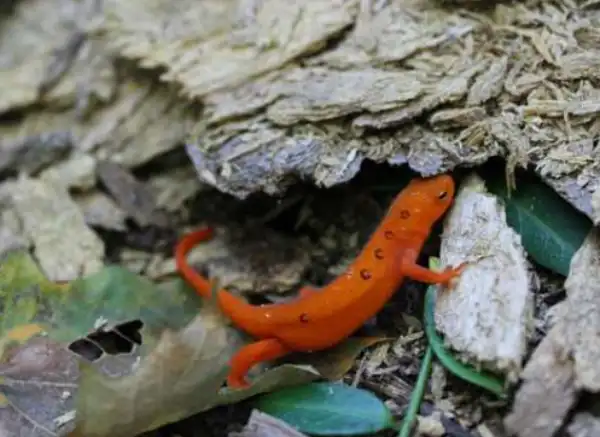
| Scientific Name | Notopthalmus viridescens |
| Size | 5 to 13 cm in length |
| Habitat | North America |
| Diet | Mainly carnivorous and feeds on insects |
| Coloring feature | Aposematism |
If you are searching for an aquarium pet, then you are in the right place. This salamander is a common aquarium pet. These salamanders produce tetrodotoxin, which makes them unpalatable for their predators. It undergoes the life stages of larva, red embryo, and adult stage.
It uses a warning coloration called aposematism, which warns its predators that it is not worth eating. These are mainly carnivorous and feed on small aquatic invertebrates, insects, worms, and snails every 2 to 3 days.
The Eastern Newt salamanders use scientific magnetic orientation for homing and also use their magnetoreception system.
Another interesting fact about these red-spotted salamanders is that if their limbs are damaged or lost due to injury, then they have the ability for limbic regeneration.
Additionally, it can regenerate the spinal cord, heart, and other organs. This shows that they have immense ability in stem cells.
4. New forest burnet
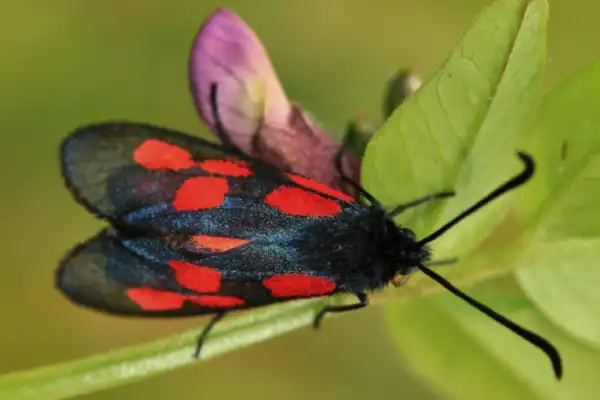
| Scientific Name | Zygaena viciae |
| Size | Wingspan is 22-32 mm |
| Habitat | Europe mainly England |
| Diet | In the larvae stage feeds on leaves |
| Coloring feature | Warningly colored and produce cyanide |
Sadly, this red-spotted beautiful species has been threatened. One of its subspecies is already extinct. Presently, Scotland is the only site where this species can be found.
In 1927, it went extinct in a new forest, hence the name ‘new forest’. Many subspecies of this moth do have red spots on their wings.
These moths fly mainly during the days in July and August. This species undergoes the life stage of being a larva and then a moth.
During the larval stage, they particularly feed on one type of leaf, go into hibernation, and then turn into a moth. This whole process takes a year.
5. Red-spotted lily weevil
| Scientific Name | Brachycerus ornatus |
| Size | 25-45 mm |
| Habitat | Sub-Saharan African area |
| Diet | Feeds on lily |
| Coloring feature | Warning coloration |
If one wants to see this insect, it appears only when there is a downpour and where the lily grows. These red-spotted insects are highly dependent on their host plants.
Very little is known about the life stages of these beetles. If these beetles have any enemies, then it has to be ants, because the ants scoop out the eggs that the weevils have left behind next to the lily plant. Both larvae and adult lily weevils feed on lily plants and their leaves.
In southern Africa, the exoskeleton of these beautiful beetles is used for making beads for accessories, jewelry, and specific necklaces.
This is because the beetles use aposematism for protection, which makes the predator feel like the beetle is not tasteless. Hence, in southern Africa, this property is represented and used to make jewelry as witchcraft.
6. Red-spotted toad
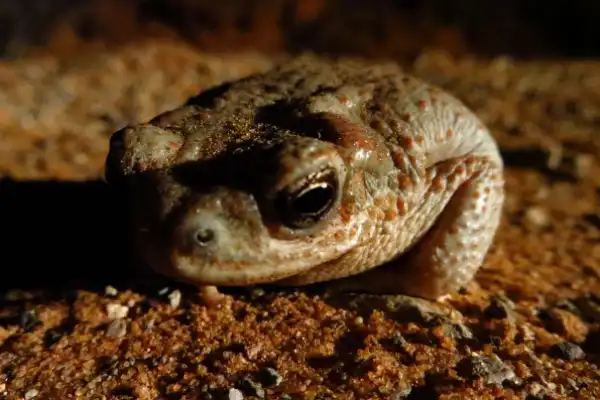
| Scientific Name | Anaxyrus punctatus |
| Size | 3.7 to 7.5 cm |
| Habitat | Southern western United States |
| Diet | Small insects |
| Coloring feature | Skin glands |
These not-so-good-looking red-dotted amphibians are found in rocky streams or riverbeds, but mainly in dry regions. In spite of living in dry areas, they require small puddles or temporary pools for breeding, as the eggs that develop into tadpoles need water.
The red-dotted toads walk around instead of hopping. The male red-dotted toads can be distinguished by the nuptial pad, developed during breeding season. The young red-dotted toads are similar to adults except for their yellow-colored feet.
Human activity is again affecting nature, and here these species are endangered by us.
7. Red-spotted severum
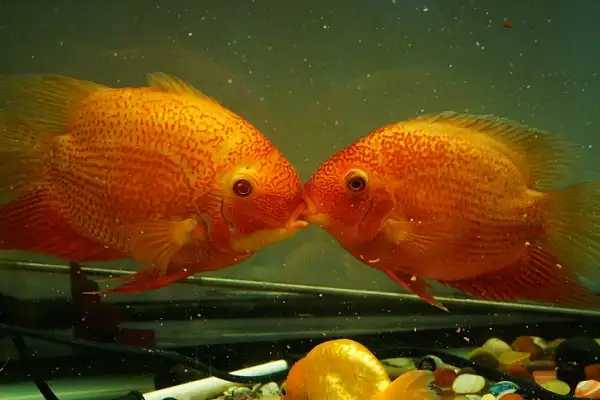
| Scientific Name | Heros severum |
| Size | 14-20cm |
| Habitat | Amazon Basin in South America |
| Diet | Frugivore |
| Coloring feature | Camouflage |
These red-spotted severums were misidentified until 2015 as aquarium traders’ mouth brooders. These species are found in calm and deep water with lots of submerged trees and roots. This needs to be attained in the aquarium for the biotope. So as pretty as these red spots are, their maintenance is difficult.
The male red-spotted severum is larger in size than the female. They lay up to 200 eggs, which are guarded by both parents. These red-spotted severum adapt easily to their surroundings.
8. Red-spotted royal snake
| Scientific Name | Spalerosophis arenarius |
| Size | 39 inches |
| Habitat | India and Pakistan |
| Diet | Carnivore |
| Coloring feature | Camouflage |
Red-spotted royal snakes look dangerous, and they are. But they can be easily held in captivity and kept as pets. These are mostly seen with snake charmers in Pakistan.
The red-spotted royal snake lives up to its name. Their pale bluff, adorned with darker spots, makes them a sight.
The red-spotted reptiles hibernate from December to February. The female lays 7–10 eggs in a burrow, and no parental care is observed.
9. Red spotted purple butterfly

| Scientific Name | Limenitis arthemis astyanax |
| Size | 3-3.5 inches |
| Habitat | Florida and Texas |
| Diet | Tree sap and fruits |
| Coloring feature | Mimic |
Anyone can identify these red-spotted butterflies. These are unique and wild types, one of the most beautiful butterflies. The red-spotted purple mimics a poisonous pipe vine swallowtail.
The red-purple admiral has a blast of colors on their wings: underside brownish black, basal blue, rows of red, and corners of white. Even their caterpillars mimic the horned bird droppings.
The red-spotted purple loves to feed on black cherries. The butterflies, though beautiful, are considered a rare species that must be protected.
10. Red spotted pit viper
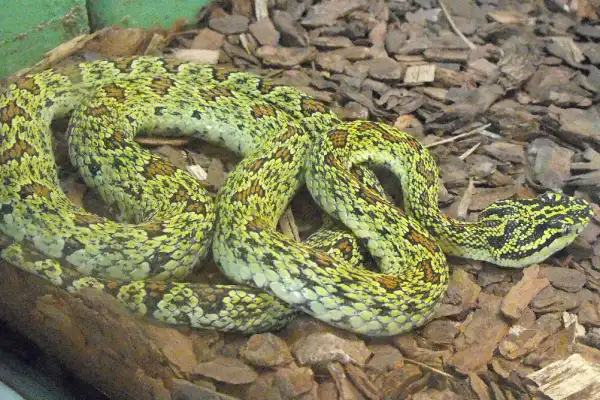
| Scientific Name | Protobothrops jerdonii |
| Size | 32.9 inches |
| Habitat | India, Nepal and China |
| Diet | Carnivore |
| Coloring feature | Camouflage |
The females are longer than the males. Weird, but these red spots were named after a herpetologist who used to collect these types of species. They prefer smaller animals like toads, insects, birds, etc. Complementary to royal snakes, these pit vipers like to live in rain forests.
They look dangerous, are red-spotted, but rarely bite humans, and their venom is less poisonous too.
Again, the red-spotted pit vipers are complementary to other snakes by showing their parental care.
So this was about animals with red spots on their bodies, and we got to know a little more about them. I hope this article was useful.
Also Read:

